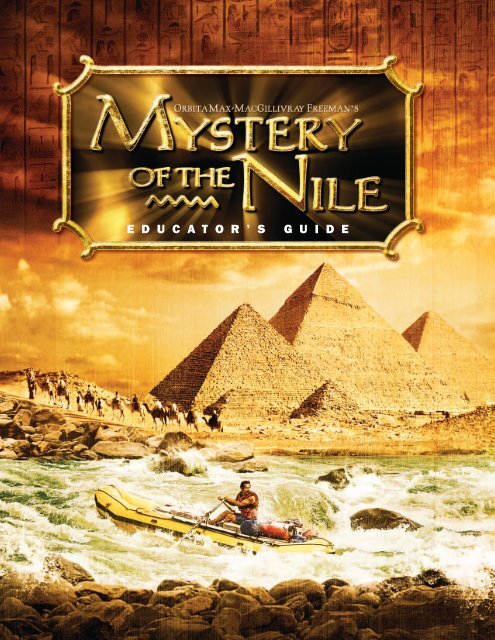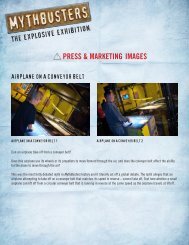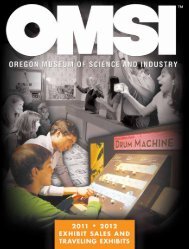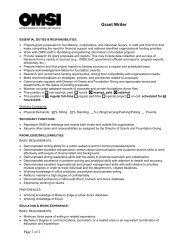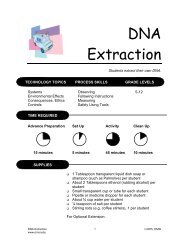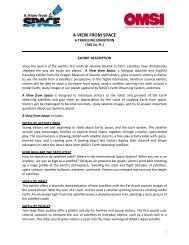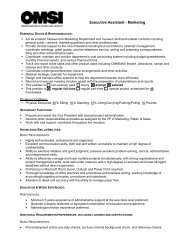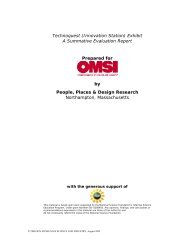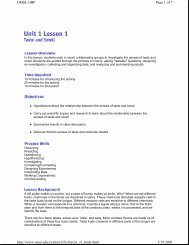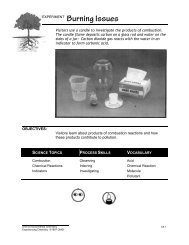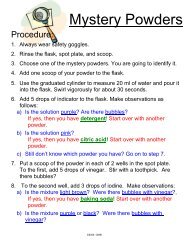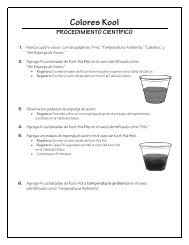Create successful ePaper yourself
Turn your PDF publications into a flip-book with our unique Google optimized e-Paper software.
E D U C A T O R ’ S G U I D E
E D U C A T O R ’ S G U I D E<br />
“The <strong>Nile</strong> is <strong>the</strong> most magnificent river in <strong>the</strong> world. No o<strong>the</strong>r river can compare.<br />
And no o<strong>the</strong>r river in <strong>the</strong> world is as closely associated with a particular culture<br />
and society as is <strong>the</strong> <strong>Nile</strong>. Without <strong>the</strong> <strong>Nile</strong> <strong>the</strong>re would be no Egypt, no pharaohs, no<br />
pyramids. The history <strong>of</strong> <strong>the</strong> western world is inextricably tied to this greatest <strong>of</strong> rivers.”<br />
—PASQUALE SCATURRO, Expedition Leader<br />
2<br />
MYSTERY OF THE NILE is an IMAX ® <strong>the</strong>atre film and a<br />
co-production <strong>of</strong> Orbita Max and MacGillivray Freeman Films.<br />
The films produced by MacGillivray Freeman Films <strong>of</strong>fer<br />
educators a powerful teaching tool that is easily integrated<br />
into existing curriculum. In addition to meeting recognized<br />
educational standards, <strong>the</strong>y provide students with unique and<br />
exciting opportunities to explore new worlds and new ideas.<br />
Both <strong>the</strong> film and this guide <strong>of</strong>fer an introductory experience<br />
for students working on a variety <strong>of</strong> subjects at a range <strong>of</strong> grade<br />
levels. The approach is premised on influencing <strong>the</strong> affective<br />
behavior <strong>of</strong> students, interesting and motivating <strong>the</strong>m long after<br />
<strong>the</strong>y have seen <strong>the</strong> film.<br />
The Guide covers material that is particularly relevant for<br />
students studying environmental and ecological subjects including<br />
conservation, geography and geology, history, social students,<br />
civics and even art and literature. In addition to national standardsbased<br />
lessons for students in grades 6-8, <strong>the</strong>re are enrichment<br />
activities, extensive background information, reference sources,<br />
directions for group activities and enough variety in <strong>the</strong> content<br />
to appeal to students with a wide range <strong>of</strong> abilities. Teachers are<br />
strongly encouraged to adapt <strong>the</strong> activities to meet <strong>the</strong> specific<br />
needs <strong>of</strong> <strong>the</strong> grades <strong>the</strong>y teach and <strong>the</strong>ir students.<br />
NATIONAL EDUCATION STANDARDS<br />
GRADES SUBJECT<br />
STANDARD<br />
4-6 Life Science Know about <strong>the</strong> diversity & unity that characterizes life<br />
3-5 Geography Understand how human actions modify <strong>the</strong> environment<br />
5-12 History 1b. <strong>Nile</strong> impact on development <strong>of</strong> early civilization<br />
5-12 History 2b. Cultural/political connections between Egypt/Nubia<br />
K-2 History Tech 6. Transportation tailored to societies’ means/needs<br />
3-5 Geography 17. Applying geography to interpret past<br />
K-12 English English content standards, creative writing<br />
6-8 Science Ecology, bio-diversity, conservation, water quality<br />
TABLE OF CONTENTS<br />
INTRODUCTION<br />
3 About <strong>the</strong> Film<br />
Brief History <strong>of</strong> <strong>Nile</strong> Exploration<br />
Background Information on <strong>the</strong> <strong>Nile</strong><br />
The <strong>Nile</strong> as Refuge<br />
Ancient Egypt<br />
Geological Change<br />
The <strong>Nile</strong> Cycle<br />
Controlling <strong>the</strong> <strong>Nile</strong><br />
The <strong>Nile</strong> as a means <strong>of</strong> Transportation<br />
Rivers<br />
Cultures along <strong>the</strong> <strong>Nile</strong><br />
ACTIVITIES<br />
9 1 Experience Exploration<br />
An Explorer’s Life<br />
Preparing for <strong>the</strong> Journey<br />
11 2 The Aswan Choice<br />
12 3 Do We Want a Dam?<br />
13 4 Target Tourism<br />
14 5 Rollin’ on <strong>the</strong> River—Do <strong>the</strong> Math<br />
15 6 Heiroglyph Holiday<br />
16 7 Word Pyramid<br />
RESOURCES<br />
17 Fun Facts: <strong>Nile</strong> Crocodiles, Hippos and Camels<br />
18 Glossary<br />
Bibliography<br />
Answer Key<br />
Recommended Reading and Websites
Pasquale Scaturro guides an expedition raft through Class V Island Rapid in <strong>the</strong> Western Gorges section <strong>of</strong> Ethiopia.<br />
3<br />
ABOUT THE FILM<br />
MYSTERY OF THE NILE is a cinematic adventure that<br />
takes audiences on an expedition down <strong>the</strong> world’s greatest and<br />
most deadly river, <strong>the</strong> Blue <strong>Nile</strong>. For 114 days, a team <strong>of</strong> explorers<br />
led by Pasquale Scaturro and Gordon Brown face seemingly<br />
insurmountable challenges-class VI rapids, dangerous crocodiles<br />
and hippos, gunfire from bandits, malaria, and <strong>the</strong> fierce Saharan<br />
sun-as <strong>the</strong>y make <strong>the</strong>ir way along all 3,260 miles <strong>of</strong> <strong>the</strong> river to<br />
became <strong>the</strong> first in history to complete a full descent <strong>of</strong> <strong>the</strong> Blue<br />
<strong>Nile</strong> from source to sea. Throughout <strong>the</strong> journey, <strong>the</strong> beauty and<br />
wonder <strong>of</strong> <strong>the</strong> magnificent <strong>Nile</strong> region are revealed as never before.<br />
The story <strong>of</strong> this epic journey is <strong>the</strong> subject <strong>of</strong> a large format<br />
film, MYSTERY OF THE NILE, playing in IMAX <strong>the</strong>atres and o<strong>the</strong>r<br />
large format cinemas.<br />
A BRIEF HISTORY OF NILE EXPLORATION<br />
MYSTERY OF THE NILE captures <strong>the</strong> epic story and learning<br />
adventures <strong>of</strong> <strong>the</strong> team that became <strong>the</strong> first ever to navigate <strong>the</strong><br />
waters <strong>of</strong> <strong>the</strong> Blue <strong>Nile</strong> from source to sea. But how is it that this<br />
“last <strong>of</strong> <strong>the</strong> great firsts” took so long to finally be accomplished?<br />
It hasn’t been for lack <strong>of</strong> trying. In fact, <strong>the</strong> Blue <strong>Nile</strong> has<br />
been an obsession that has driven many explorers—yet never with<br />
successful results. The massive Ethiopian rapids <strong>of</strong>ten stymied<br />
those without modern, world-class whitewater skills; <strong>the</strong> evershifting<br />
political situation <strong>of</strong>ten left explorers exposed to flying<br />
bullets, <strong>of</strong>f-limits borders and insurmountable dangers; and<br />
numerous Blue <strong>Nile</strong> expeditions were spooked by <strong>the</strong> “terrible<br />
trio” <strong>of</strong> exploring: accidents, injuries and fatalities.<br />
The entire history <strong>of</strong> <strong>Nile</strong> exploration is filled with legendary<br />
stories. Even in ancient Greece, <strong>the</strong> source <strong>of</strong> <strong>the</strong> <strong>Nile</strong> was<br />
considered one <strong>of</strong> <strong>the</strong> earth’s most compelling mysteries, written<br />
about extensively by <strong>the</strong> 460 BC historian Herodotus, who<br />
believed <strong>the</strong> river sprang from between two massive mountains.<br />
Later, <strong>the</strong> Emperor Nero ordered his centurions to follow <strong>the</strong><br />
<strong>Nile</strong> in search <strong>of</strong> this rumored source, though <strong>the</strong>se brave early<br />
explorers were bogged down in <strong>the</strong> swampy marshes <strong>of</strong> <strong>the</strong><br />
Sudd (near <strong>the</strong> Ugandan border) and got no fur<strong>the</strong>r.<br />
Historians explain that between <strong>the</strong> 4th and 17th centuries,<br />
<strong>the</strong> upper <strong>Nile</strong> in Ethiopia was largely forgotten by <strong>the</strong> rest <strong>of</strong><br />
<strong>the</strong> world. Only missionaries, merchants and adventurers reached<br />
<strong>the</strong> Ethiopian highlands. By <strong>the</strong> 17th century, attracted by <strong>the</strong><br />
legend <strong>of</strong> a Christian kingdom isolated in <strong>the</strong> heart <strong>of</strong> East Africa<br />
and surrounded by Islamic warriors, Portugal sent missionaries<br />
and soldiers to help <strong>the</strong> Ethiopian rulers and to protect <strong>the</strong> faith.<br />
It was <strong>the</strong> first contact for centuries between Europe and <strong>the</strong> old,<br />
exotic Ethiopian Christian kingdom (mentioned in some<br />
chronicles as <strong>the</strong> “Preste Juan” kingdom). The Portuguese built<br />
castles and bridges and provided cannons to ward <strong>of</strong>f <strong>the</strong> Islamic<br />
soldiers. At that time, a Spanish missionary was <strong>the</strong> first to visit<br />
and describe <strong>the</strong> Tisissat Falls and <strong>the</strong> upper section <strong>of</strong> <strong>the</strong> <strong>Nile</strong>.<br />
By <strong>the</strong> 19th Century, <strong>the</strong> great Victorian era <strong>of</strong> African<br />
exploration, finding <strong>the</strong> source <strong>of</strong> <strong>the</strong> <strong>Nile</strong> became known as<br />
“<strong>the</strong> Great Prize.” With <strong>the</strong> river’s massive, maze-like structure,<br />
<strong>the</strong> source <strong>of</strong> all <strong>the</strong> water remained hidden from view, and many<br />
believed that finding it would hold out <strong>the</strong> quarry <strong>of</strong> tremendous<br />
hydrological power ready to be harnessed by <strong>the</strong> discoverer.
4<br />
Some <strong>of</strong> <strong>the</strong> most courageous and innovative explorers <strong>of</strong> this<br />
era set out to accomplish this crowning achievement <strong>of</strong> human<br />
knowledge. Among those who searched are:<br />
Padre Páez (-1622): This brave Spanish missionary, who was sent<br />
to Ethiopia in <strong>the</strong> beginning <strong>of</strong> <strong>the</strong> XVII century to convert <strong>the</strong><br />
Ethiopian Orthodox Church to Catholicism and who became<br />
a close friend <strong>of</strong> <strong>the</strong> Emperor Susinios, travelled through <strong>the</strong><br />
country undertaking many risky expeditions. He was <strong>the</strong> first<br />
westerner to “discover” and to describe <strong>the</strong> source <strong>of</strong> <strong>the</strong> Blue<br />
<strong>Nile</strong>. Páez saw <strong>the</strong> sources <strong>of</strong> <strong>the</strong> Blue <strong>Nile</strong> on April 21st, 1618:<br />
“I confess I feel fortunate and happy for seeing what Alexander<br />
<strong>the</strong> Great, Julius Caesar and <strong>the</strong> Kings Ciro and Cambesses<br />
desired to see in <strong>the</strong> past but never accomplished”. Padre Páez<br />
was a very humble person who never proclaimed his achievement<br />
as a “discovery.” He always explained and wrote in his notes that<br />
he “saw” <strong>the</strong> source <strong>of</strong> <strong>the</strong> <strong>Nile</strong>, given <strong>the</strong> Ethiopians already<br />
knew it and venerated its sacred waters. They called <strong>the</strong> source<br />
“Guish Abbay” and <strong>the</strong> first section <strong>of</strong> <strong>the</strong> Blue <strong>Nile</strong> <strong>the</strong><br />
“Guelguel Abbay.” Padre Paez has been recognized in 2003 by<br />
<strong>the</strong> Ethiopian authorities as <strong>the</strong> first European to visit <strong>the</strong> source<br />
<strong>of</strong> <strong>the</strong> Blue <strong>Nile</strong>. Years after, <strong>the</strong> explorer James Bruce knew <strong>the</strong><br />
story <strong>of</strong> Padre Páez, but still proclaimed himself as <strong>the</strong> “discoverer”<br />
<strong>of</strong> <strong>the</strong> Blue <strong>Nile</strong> source.<br />
James Bruce (1730-94): This<br />
Scottish explorer set <strong>of</strong>f from Cairo in<br />
1768 and after a long, hard journey<br />
arrived at Lake Tana in 1770,<br />
confirming for <strong>the</strong> first time that<br />
this mountain lake is <strong>the</strong> origin <strong>of</strong><br />
<strong>the</strong> Blue <strong>Nile</strong>—though at that time<br />
no one in Great Britain knew this<br />
was actually <strong>the</strong> primary source <strong>of</strong><br />
James Bruce<br />
<strong>the</strong> entire <strong>Nile</strong> River.<br />
Samuel Baker (1821-1893): Baker was an English explorer who<br />
became <strong>the</strong> greatest expert on Egypt and Sudan <strong>of</strong> his day.<br />
His 1860s hunt for <strong>the</strong> source <strong>of</strong> <strong>the</strong> <strong>Nile</strong> led to <strong>the</strong> European<br />
discovery <strong>of</strong> Lake Albert in Central Africa.<br />
Richard Burton (1821-1890): <strong>the</strong><br />
legendary storyteller and explorer<br />
joined up with John Hanning<br />
Speke (1827-1864) in 1858, to<br />
search for rumored great lakes in<br />
Central Africa that might be <strong>the</strong><br />
source <strong>of</strong> <strong>the</strong> <strong>Nile</strong>. Their journey<br />
took <strong>the</strong>m to Lake Tanganiyaka and<br />
<strong>the</strong> challenging Mountains <strong>of</strong> <strong>the</strong><br />
Sir Richard Burton<br />
Moon. In mid-journey, Burton took<br />
ill and rested, while Speke pressed on, eventually becoming <strong>the</strong><br />
first European to ever lay eyes on Lake Victoria, <strong>the</strong>n considered<br />
<strong>the</strong> main source <strong>of</strong> <strong>the</strong> <strong>Nile</strong>.<br />
Bruckhart Waldekker: A little-known German explorer,<br />
Waldekker quietly proved in 1937 that <strong>the</strong> main source <strong>of</strong> <strong>the</strong><br />
<strong>Nile</strong> is <strong>the</strong> Ethiopian highlands, which contribute over 85%<br />
<strong>of</strong> <strong>the</strong> river’s water, while Lake Victoria contributes only 15%.<br />
In <strong>the</strong> modern era, numerous expeditions have been attempted<br />
on <strong>the</strong> Blue <strong>Nile</strong>, with several intrepid river-runners attempting<br />
<strong>the</strong> dangerous route from Laka Tana to <strong>the</strong> Mediterranean Sea.<br />
Some <strong>of</strong> <strong>the</strong>se have included:<br />
1902 Expedition: American big-game hunter W.N. Macmillan<br />
and Norwegian explorer B.H. Jenson became <strong>the</strong> first to try to<br />
run <strong>the</strong> Blue <strong>Nile</strong>, but <strong>the</strong>ir boats were wrecked beyond repair<br />
almost immediately upon entering <strong>the</strong> strong current.<br />
1968 Expedition: Emperor Haile<br />
Selassie <strong>of</strong> Ethiopia himself invited<br />
<strong>the</strong> British Army to attempt <strong>the</strong><br />
first descent <strong>of</strong> <strong>the</strong> Blue <strong>Nile</strong> in<br />
1968. A massive 60-man team<br />
was assembled by Captain John<br />
Blashford-Snell, who also had a<br />
support plane, Land Rovers and<br />
assault-style rafts at his disposal.<br />
Captain John Blashford-Snell<br />
Even so, <strong>the</strong> cumbersome expedition<br />
soon met its match on <strong>the</strong> river. Many boiling rapids had to be<br />
by-passed and portaged. The team faced tragedy when one <strong>of</strong> <strong>the</strong>ir<br />
key members, Ian Macloed, drowned while trying to cross a<br />
tributary. They were <strong>the</strong>n forced to evade attacks from bandits<br />
while camping in <strong>the</strong> Blue <strong>Nile</strong> Gorge, and evacuated <strong>the</strong> region.<br />
1972 Expedition: A sleeker 4-man British team, under <strong>the</strong><br />
leadership <strong>of</strong> highly experienced kayakers Mike Jones and Mick<br />
Hopkins, ran many <strong>of</strong> <strong>the</strong> monster white-water Ethiopian rapids<br />
that <strong>the</strong> 1968 expedition had found impossible. Never<strong>the</strong>less,<br />
<strong>the</strong>y left <strong>the</strong> river after 12 days, after being attacked repeatedly<br />
by crocodiles and gun-wielding Shifta bandits.<br />
1999 Expedition: This National Geographic Society expedition<br />
ran 500 miles <strong>of</strong> <strong>the</strong> Blue <strong>Nile</strong> from <strong>the</strong> headwaters <strong>of</strong> Lake Tana<br />
to <strong>the</strong> Sudanese border, <strong>the</strong> first time this length had been run in<br />
an unbroken journey. Veteran river runner Kelly Shannon led <strong>the</strong><br />
journey which also ran into numerous hazards, including rapids<br />
that could not be run necessitating long portages through remote<br />
country. National Geographic Magazine depicted <strong>the</strong> area’s people<br />
and landscape in an article about <strong>the</strong> expedition—<strong>the</strong> first time<br />
Westerners had ever seen <strong>the</strong> spectacular beauty <strong>of</strong> <strong>the</strong> Blue <strong>Nile</strong>.<br />
So why did Pasquale Scaturro and Gordon Brown succeed where<br />
all o<strong>the</strong>rs have failed for thousands <strong>of</strong> years? Modern equipment,<br />
exceptional experience, strong wills and a healthy dose <strong>of</strong> luck<br />
Pasquale Scaturro instructs hydrologist Mohammed Megahed how to rappel <strong>of</strong>f <strong>of</strong> <strong>the</strong><br />
top <strong>of</strong> Tissisat Falls.
5<br />
all likely have something to do with it. But <strong>the</strong>ir triumph in<br />
paddling from <strong>the</strong> highlands <strong>of</strong> Ethiopia to <strong>the</strong> sea at Alexandria<br />
without disaster may simply be ano<strong>the</strong>r MYSTERY OF THE NILE.<br />
BACKGROUND INFORMATION ON THE NILE<br />
The <strong>Nile</strong> as Refuge<br />
The geographical diversity <strong>of</strong> <strong>the</strong> <strong>Nile</strong> is unmatched anywhere.<br />
From its volcanic and glacial birthplace in <strong>the</strong> mountains to<br />
where it plunges into <strong>the</strong> salt waters <strong>of</strong> <strong>the</strong> Mediterranean Sea,<br />
<strong>the</strong> <strong>Nile</strong> is characterized by variation. If “history exists with <strong>the</strong><br />
consent <strong>of</strong> geography,” as <strong>the</strong> writer Will Durant has suggested,<br />
<strong>the</strong> <strong>Nile</strong> was destined to have an interesting life. From ancient<br />
times to <strong>the</strong> present, along <strong>the</strong> banks <strong>of</strong> this river, a huge and<br />
truly diverse human population has flourished. It is not surprising<br />
<strong>the</strong>n to find that plant and animal life has been no less diverse.<br />
Thousands <strong>of</strong> species <strong>of</strong> plants <strong>of</strong> every conceivable color,<br />
shape and size have established <strong>the</strong>mselves and provide shelter<br />
and sustenance to an equally varied animal kingdom. It is a land<br />
where <strong>the</strong> extreme is common. Earthworms can grow to three<br />
feet and canaries can measure fifteen feet from peak to tail.<br />
The equatorial rain-belt, which spans most <strong>of</strong> <strong>the</strong> middle <strong>of</strong><br />
Africa, supports a large population <strong>of</strong> birds, both residents and<br />
migrants, some <strong>of</strong> which are truly rare and fascinating indeed.<br />
And you would be hard pressed to imagine creatures more diverse<br />
than <strong>the</strong> giraffe, (formerly known as <strong>the</strong> camel-leopard), <strong>the</strong><br />
walking stick or <strong>the</strong> “spitting” cobra.<br />
One <strong>of</strong> <strong>the</strong> pyramids <strong>of</strong> Giza, south <strong>of</strong> Cairo.<br />
Ancient Egypt<br />
There are two factors that enabled <strong>the</strong> ancient Egyptians to evolve<br />
a civilization that has been admired for millennia. One was <strong>of</strong><br />
course <strong>the</strong> <strong>Nile</strong>, as noted so eloquently by Herodotus, known<br />
as <strong>the</strong> fa<strong>the</strong>r <strong>of</strong> History. The o<strong>the</strong>r is what has been called its<br />
“splendid geographical location.” Protected from <strong>the</strong> north by <strong>the</strong><br />
narrow coasts <strong>of</strong> <strong>the</strong> Mediterranean, from <strong>the</strong> south by several<br />
treacherous cataracts (rapids), and on ei<strong>the</strong>r side by deserts that<br />
were as inhospitable <strong>the</strong>n as now, Egypt was able to develop its<br />
own society on its own terms.<br />
Early on, about 12,000 years ago, Egyptians saw <strong>the</strong> merits<br />
<strong>of</strong> an agrarian society that could get additional protein from fish,<br />
migrating birds and larger mammals. Later on, climate change<br />
may have played a role in driving people back to a hunting and<br />
ga<strong>the</strong>ring lifestyle. Artifacts have been found that attest to this<br />
change. By about 5500 BC, <strong>the</strong> Egyptians were well established<br />
in permanent communities, domesticating animals and planting<br />
early varieties <strong>of</strong> barley and emmer.<br />
Geological Change<br />
160 million years ago, <strong>the</strong> continents drifted apart creating<br />
channels for <strong>the</strong> two mighty rivers <strong>of</strong> <strong>the</strong> Americas, <strong>the</strong> Amazon<br />
and <strong>the</strong> Mississippi, as well as a substantial trench for <strong>the</strong> longest<br />
The expedition team floats through a portion <strong>of</strong> <strong>the</strong> <strong>Nile</strong> river.<br />
river on earth—<strong>the</strong> <strong>Nile</strong>. In that era, <strong>the</strong> <strong>Nile</strong> emptied into <strong>the</strong><br />
Indian Ocean. Millions <strong>of</strong> years passed and during that time<br />
massive changes took place. Seas, including <strong>the</strong> Mediterranean,<br />
were created, lakes were divided, mountains rose and were<br />
diminished. Following <strong>the</strong> last Ice Age, <strong>the</strong>re was a rainy period<br />
in Africa that lasted some 6,000 years. Heavy rains falling on <strong>the</strong><br />
Ethiopian highlands sent torrents <strong>of</strong> water rushing downstream,<br />
sweeping mud, silt, sand, gravel and even large rocks and boulders<br />
along its path. Over time, <strong>the</strong> water and stones scoured away at<br />
<strong>the</strong> earth creating a deep canyon and establishing a track for <strong>the</strong><br />
river as it now raced along to <strong>the</strong> Mediterranean Sea. Then <strong>the</strong><br />
rainy period ended and <strong>the</strong> land to <strong>the</strong> east and west <strong>of</strong> <strong>the</strong> <strong>Nile</strong>,<br />
particularly in Egypt, became a place, as some say, suitable only<br />
for scorpions and rattlesnakes.<br />
But <strong>the</strong> <strong>Nile</strong> itself became a refuge for wildlife. Hunters and<br />
hunted were drawn, as if by a magnet, to <strong>the</strong> banks <strong>of</strong> <strong>the</strong> <strong>Nile</strong><br />
to nourish <strong>the</strong>mselves and pursue <strong>the</strong> business <strong>of</strong> living. Along<br />
<strong>the</strong> banks <strong>of</strong> <strong>the</strong> river, greater and lesser civilizations flourished<br />
and declined. Among <strong>the</strong> former was Pharaonic Egypt, living in<br />
a slice <strong>of</strong> time from about 3000 BC until 30 BC, when Egypt<br />
became part <strong>of</strong> <strong>the</strong> Roman Empire.<br />
The <strong>Nile</strong> Cycle<br />
For more than 5,000 years, <strong>the</strong> cycle <strong>of</strong> <strong>the</strong> <strong>Nile</strong> was unchanged.<br />
Each year a flood <strong>of</strong> water (<strong>the</strong> inundation) came cascading<br />
down <strong>the</strong> river bringing with it rich nutrients from <strong>the</strong> highlands<br />
<strong>of</strong> Ethiopia. In full flood, <strong>the</strong> muddy waters overflowed<br />
<strong>the</strong> river banks and spread out to prepare <strong>the</strong> fields for planting.<br />
The ancient Egyptians did not know where <strong>the</strong> waters<br />
came from. Some said that <strong>the</strong>y came from a bottomless water<br />
jar, hidden in a cavern beneath <strong>the</strong> mountains at Aswan, and<br />
released at <strong>the</strong> appropriate time by <strong>the</strong> god Hapy. O<strong>the</strong>rs<br />
credited Khnum, an ancient creator god who also lived in <strong>the</strong>
7<br />
vicinity <strong>of</strong> <strong>the</strong> First Cataract. Still o<strong>the</strong>r rituals honoured Osiris<br />
who, according to tradition, was killed and cut into little pieces<br />
by Seth, his jealous bro<strong>the</strong>r. Isis, wife <strong>of</strong> Osiris, pieced him<br />
toge<strong>the</strong>r and brought him back to life (symbolizing crop renewal).<br />
It was her tears <strong>of</strong> mourning that were said to raise <strong>the</strong> waters<br />
<strong>of</strong> <strong>the</strong> <strong>Nile</strong>.<br />
The ancients had calculated when <strong>the</strong> waters would come.<br />
Priest-astronomers, watching and recording what happened in<br />
<strong>the</strong> skies, had noted that Sirius, <strong>the</strong> Dog star, would disappear<br />
each year for about 70 days, eclipsed by <strong>the</strong> sun. It would <strong>the</strong>n<br />
re-appear and shortly <strong>the</strong>reafter <strong>the</strong> waters would begin to rise.<br />
Watching with interest was<br />
<strong>the</strong> Pharaoh and his tax<br />
collectors. Under <strong>the</strong> Egyptian<br />
system, all land was owned by<br />
<strong>the</strong> Pharaoh and controlled<br />
by bureaucrats and temple<br />
priests. Peasants were taxed,<br />
not on how much <strong>the</strong>y grew<br />
but on how much <strong>the</strong>y should<br />
have grown. The Nilometer<br />
predicted that amount to<br />
some extent. Gauges located<br />
along <strong>the</strong> river recorded its<br />
height and, <strong>the</strong>oretically, <strong>the</strong><br />
extent <strong>of</strong> <strong>the</strong> fields that would<br />
Luxor Temple<br />
be coved by <strong>the</strong> inundation.<br />
Fields that were always covered by <strong>the</strong> inundation were taxed<br />
at <strong>the</strong> highest rate, those that sometimes received <strong>the</strong> inundation<br />
were taxed at <strong>the</strong> middle rate, while those that never flooded<br />
and had to be watered by hand were taxed at <strong>the</strong> lowest rate.<br />
According to <strong>the</strong> tax collectors, it was a simple matter. Wait for<br />
<strong>the</strong> flood waters to subside, which took about 100 days, plant<br />
<strong>the</strong> seed, use <strong>the</strong> sharp hooves <strong>of</strong> sheep and goats to drive <strong>the</strong><br />
seed into <strong>the</strong> muddy soil and <strong>the</strong>n simply wait for <strong>the</strong> hot sun<br />
to do <strong>the</strong> rest. The grain was converted into bread and beer.<br />
For most <strong>of</strong> its history, Egypt produced enough grain to feed<br />
its own people and to export a large surplus.<br />
The difference between not having enough water and having<br />
too much was about six steps on <strong>the</strong> Nilometer, so <strong>the</strong> gauge<br />
was watched very carefully. The Nilometer was <strong>the</strong> instrument<br />
that, in <strong>the</strong> short term at least, forecast how <strong>the</strong> Nation would<br />
fare next season.<br />
Controlling <strong>the</strong> <strong>Nile</strong><br />
The first dam that was built on <strong>the</strong> <strong>Nile</strong> River was constructed<br />
around 2900 BC, in <strong>the</strong> Archaic Period, to protect <strong>the</strong> capital <strong>of</strong><br />
Lower Egypt (known as Memphis, at <strong>the</strong> time) from flooding.<br />
The timing <strong>of</strong> <strong>the</strong> annual flood was fairly predictable. Records<br />
kept on behalf <strong>of</strong> <strong>the</strong> Pharaoh confirm that <strong>the</strong> floods arrived<br />
in Egypt sometime after <strong>the</strong> middle <strong>of</strong> May and before <strong>the</strong> end<br />
<strong>of</strong> June. It was a predictable cycle and capitol works projects,<br />
such as <strong>the</strong> construction <strong>of</strong> a pyramid, could be confidently<br />
scheduled. What was uncertain however, even into modern<br />
times, was <strong>the</strong> extent <strong>of</strong> <strong>the</strong> flood. Everyone from Egyptian<br />
priests to British hydrologists tried to find a means to predict <strong>the</strong><br />
level <strong>of</strong> flood waters—without success. Yet <strong>the</strong> stability and<br />
economic prospects <strong>of</strong> <strong>the</strong> Egyptian state relied on that.<br />
When too much <strong>of</strong> an inundation occurred, <strong>the</strong> waters<br />
invaded homes and temples, dissolving <strong>the</strong> mud bricks used for<br />
construction and generally disrupting life. Yet even that was<br />
preferable to <strong>the</strong> spectre <strong>of</strong> a low flood or, worse still, a series <strong>of</strong><br />
such events. Several low floods in a row meant that dust and<br />
famine would stalk <strong>the</strong> land.<br />
The <strong>Nile</strong> as a means <strong>of</strong> transportation<br />
The <strong>Nile</strong> River is a natural “highway” that runs from one side <strong>of</strong><br />
Egypt to <strong>the</strong> o<strong>the</strong>r. For more than 5,000 years, it was <strong>the</strong> principal<br />
means <strong>of</strong> communication and transportation. It linked Upper and<br />
Lower Egypt: vast areas <strong>of</strong> desert on ei<strong>the</strong>r side only increased its<br />
importance. On its waters, a variety <strong>of</strong> boats carried trade goods,<br />
building materials, collectors <strong>of</strong> tax and tribute, peasants, priests<br />
with sacred effigies, merchants and military might. South <strong>of</strong> Egypt,<br />
upstream, <strong>the</strong> <strong>Nile</strong> was historically less helpful in transportation<br />
due to cataracts or rapids, steep canyon walls, <strong>the</strong> turbulent<br />
Blue <strong>Nile</strong> and <strong>the</strong> vast extent <strong>of</strong> <strong>the</strong> swamp called <strong>the</strong> Sudd.<br />
An expedition raft heads through territory few outsiders have ever seen.<br />
Rivers<br />
If you were to look at Planet Earth from space you would notice<br />
that a network <strong>of</strong> rivers encircles <strong>the</strong> globe, following much <strong>the</strong><br />
same pattern as <strong>the</strong> human circulatory system. Various tributaries<br />
feed <strong>the</strong> major rivers <strong>of</strong> <strong>the</strong> world, including <strong>the</strong> <strong>Nile</strong>, and smaller
8<br />
rivers and streams, in turn, nourish <strong>the</strong>se. Collectively, <strong>the</strong>ir “job”<br />
is to transport fresh water to <strong>the</strong> ocean. And some are pretty<br />
good at it. When <strong>the</strong> Amazon reaches <strong>the</strong> Atlantic Ocean, it is<br />
carrying close to 25% <strong>of</strong> all <strong>the</strong> water that flows in <strong>the</strong> world’s<br />
rivers. The <strong>Nile</strong> may indeed be longer but <strong>the</strong>re is no argument<br />
about who is mightier.<br />
Enroute to <strong>the</strong> sea, rivers serve a number <strong>of</strong> functions:<br />
providing water for a variety <strong>of</strong> purposes: drinking, bathing,<br />
washing dishes, irrigating crops; transporting people and goods;<br />
serving as state and national boundaries; creating hydro-electric<br />
power; <strong>of</strong>fering opportunities for recreation, assisting in<br />
manufacturing; providing habitats for plants, fish, birds and<br />
o<strong>the</strong>r animals. In fact, when you stop to think about it, rivers<br />
and <strong>the</strong> water from rivers have a continuing impact on our lives.<br />
Normally we take <strong>the</strong> river and <strong>the</strong> gifts that it brings for<br />
granted. It is only when something goes “wrong” that it grabs our<br />
attention. Flooding is one <strong>of</strong> those natural events that can wreak<br />
havoc in a short span <strong>of</strong> time damaging crops and buildings<br />
and snuffing out lives in a heartbeat. You have only to look in<br />
<strong>the</strong> newspapers or watch <strong>the</strong> news on television to find easily<br />
somewhere in <strong>the</strong> world where <strong>the</strong>y temporarily have too much<br />
water (flooding) or too little (drought). The Yellow River in<br />
China flooded extensively in 1887 and again in 1938, causing<br />
approximately a million deaths each time. The death toll from<br />
<strong>the</strong> Yangtse has also been very high.<br />
Cultures Along <strong>the</strong> <strong>Nile</strong><br />
The continent <strong>of</strong> Africa,<br />
birthplace <strong>of</strong> humanity, is<br />
home to almost a billion people,<br />
speaking more than 2,000<br />
languages and dialects, and living<br />
in more than 50 countries.<br />
The continent is immense<br />
and extremely diverse, supporting<br />
<strong>the</strong> greatest populations<br />
<strong>of</strong> wildlife anywhere<br />
on <strong>the</strong> planet. The range <strong>of</strong><br />
environments run <strong>the</strong> gamut<br />
from rainforest to desert and<br />
<strong>the</strong> plant, animal and human<br />
adaptations to <strong>the</strong>se environments<br />
are equally varied.<br />
Along <strong>the</strong> length <strong>of</strong> <strong>the</strong> <strong>Nile</strong> from ancient times to today,<br />
A young Amhara girl along <strong>the</strong> banks <strong>of</strong><br />
<strong>the</strong> Blue <strong>Nile</strong><br />
humans have responded to <strong>the</strong> opportunities and challenges <strong>of</strong><br />
living, in <strong>the</strong>ir own distinctive fashion. In <strong>the</strong> film, <strong>the</strong>re is time<br />
enough to only catch some glimpses <strong>of</strong> this variation and to<br />
gain an appreciation for what is unseen. When you consider that<br />
<strong>the</strong> continental United States could fit comfortably into <strong>the</strong><br />
footprint <strong>of</strong> <strong>the</strong> Sahara Desert, it gives one some sense <strong>of</strong> scale,<br />
and in that immensity <strong>the</strong>re is a lot <strong>of</strong> scope for biodiversity.<br />
Ten countries share in <strong>the</strong> waters <strong>of</strong> <strong>the</strong> <strong>Nile</strong> basin yet each, over<br />
time, developed its own unique culture and outlook. In <strong>the</strong> Sudan<br />
alone, Africa’s largest country, 400 distinct languages emerged<br />
as well as characteristically different lifestyles. Life became a<br />
cultural smorgasbord.<br />
Pasquale Scaturro meets indigenous people along <strong>the</strong> river.<br />
The culture that is best known to <strong>the</strong> world is undeniably<br />
that <strong>of</strong> Egypt that has had a major impact on western civilization,<br />
influencing our art, architecture, religion, medicine and even<br />
fashion in enduring ways. Thanks to <strong>the</strong> gifts <strong>of</strong> <strong>the</strong> <strong>Nile</strong>, which<br />
practically demanded pursuit <strong>of</strong> an agrarian way <strong>of</strong> life, <strong>the</strong><br />
ancients evolved a highly structured and disciplined society which<br />
led Egypt to peaks <strong>of</strong> human achievement <strong>of</strong>ten admired but<br />
seldom attained. Their existence was highly insular and <strong>the</strong>y<br />
developed an ethnocentric outlook that led <strong>the</strong>m to conclude<br />
that Egypt was <strong>the</strong> best <strong>of</strong> all possible worlds and that paradise<br />
was just a somewhat improved version <strong>of</strong> <strong>the</strong> things to which<br />
<strong>the</strong>y had become accustomed.<br />
Egypt was not <strong>the</strong> only country that had pharaohs and<br />
pyramids. Southward, up <strong>the</strong> <strong>Nile</strong> in what is now <strong>the</strong> modern<br />
nation <strong>of</strong> Sudan, a mighty civilization emerged. Between 725 BC<br />
and 300 AD <strong>the</strong> kingdom <strong>of</strong> Kush rose to its pinnacle and <strong>the</strong>n<br />
subsided. Egypt and Nubia had long had a history <strong>of</strong> conflict<br />
exacerbated no doubt by <strong>the</strong> Egyptian tendency to look on Nubia<br />
as a private hunting preserve for human and animal game. In<br />
<strong>the</strong>ir writings, <strong>the</strong> Egyptians almost always spoke <strong>of</strong> <strong>the</strong>ir<br />
neighbors in pejorative terms and <strong>the</strong>re is little doubt that many<br />
regarded Nubia as an inferior frontier that could be exploited<br />
for its gold, ivory and slaves. But between 747 BC and 656 BC<br />
five “Black Pharaohs” ruled over both Egypt and Nubia before<br />
being displaced by <strong>the</strong> Assyrians. In <strong>the</strong> film, you will see some<br />
<strong>of</strong> <strong>the</strong> Kushite pyramids, which, while more numerous than<br />
<strong>the</strong> Egyptian ones, were significantly smaller and had a much<br />
steeper angle <strong>of</strong> inclination.<br />
The relationship between Egypt and Ethiopia was somewhat<br />
more civil if only because <strong>of</strong> <strong>the</strong> distance separating both countries.<br />
Ethiopia’s high mountain ranges kept it as effectively isolated<br />
as Egypt’s deserts. But that didn’t stop <strong>the</strong> two <strong>of</strong> <strong>the</strong>m from<br />
quarrelling with each o<strong>the</strong>r. It must be remembered that 85%<br />
<strong>of</strong> <strong>the</strong> <strong>Nile</strong> water reaching Egypt comes, with its rich nutrients,<br />
from Ethiopia. The ancient fear that Ethiopia could suddenly<br />
turn <strong>of</strong>f that tap nurtured Egyptian paranoia and led directly<br />
to <strong>the</strong> construction <strong>of</strong> <strong>the</strong> Aswan Dam. Ethiopia has been a<br />
stronghold <strong>of</strong> Christianity for almost two millennia while most<br />
<strong>of</strong> Egypt is Moslem. But religion has not been as divisive a force<br />
as debates on <strong>the</strong> future <strong>of</strong> <strong>the</strong> <strong>Nile</strong>—debates guaranteed to grow<br />
more heated as population pressures increase and water for all<br />
becomes an elusive objective.
9<br />
A C T I V I T Y 1<br />
Experience<br />
Exploration<br />
SKILLS USED IN THESE ACTIVITIES:<br />
Research, creative writing, analysis<br />
KEY WORD:<br />
Source: <strong>the</strong> place where a river begins to flow, <strong>the</strong><br />
beginning <strong>of</strong> a river.<br />
BACKGROUND:<br />
For more than two millennia, people have been<br />
searching for <strong>the</strong> source <strong>of</strong> <strong>the</strong> <strong>Nile</strong>. Some <strong>of</strong> those<br />
who tried include:<br />
Herodotus, <strong>the</strong> world’s first historian<br />
Nero, <strong>the</strong> Roman Emperor<br />
Ptolemy, <strong>the</strong> Greek astronomer/geographer<br />
James Bruce, <strong>the</strong> Scottish explorer<br />
John Speke, <strong>the</strong> Englishman<br />
Padre Paez, Spanish priest<br />
Adolf Linent, <strong>the</strong> Belgian<br />
Sir Samuel Baker, English explorer<br />
Burkhardt Waldecker, German explorer<br />
Some were more successful than o<strong>the</strong>rs.<br />
The secret <strong>of</strong> <strong>the</strong> beginning <strong>of</strong> <strong>the</strong> <strong>Nile</strong> remained<br />
an elusive mystery for many centuries. Many early<br />
explorers thought <strong>the</strong>y had found <strong>the</strong> answer to <strong>the</strong><br />
mystery <strong>of</strong> <strong>the</strong> <strong>Nile</strong> only to be proved wrong, sometimes<br />
centuries later. Then, a bit more than a century<br />
ago, it was discovered that <strong>the</strong> <strong>Nile</strong> originated from<br />
two sources. The source <strong>of</strong> <strong>the</strong> White <strong>Nile</strong> is Lake<br />
Victoria; <strong>the</strong> major source <strong>of</strong> <strong>the</strong> Blue <strong>Nile</strong> is Lake<br />
Tana. Both <strong>of</strong> <strong>the</strong>se natural reserviors are fed by tiny<br />
springs and rainfall.<br />
The very beginning <strong>of</strong> <strong>the</strong> Little Blue <strong>Nile</strong> is a muddy stream. It starts at <strong>the</strong> Springs<br />
<strong>of</strong> Gish Abay at Sakala Springs and reaches to Lake Tana.<br />
TEAM ACTIVITY:<br />
An Explorer’s Life<br />
TO DO:<br />
There are nine explorers’ names listed on <strong>the</strong> left and<br />
provided on <strong>the</strong> “copy page” for you to print and clip.<br />
Make copies <strong>of</strong> <strong>the</strong> “copy page” providing enough<br />
duplicates so that every student will have a name slip.<br />
Place <strong>the</strong> name slips into a hat, <strong>the</strong>n have students<br />
draw name slips to select <strong>the</strong>ir explorer. Those who<br />
have selected <strong>the</strong> same name will work toge<strong>the</strong>r as<br />
a team and use <strong>the</strong> library, <strong>the</strong> internet, or o<strong>the</strong>r<br />
resources to answer <strong>the</strong> following questions:<br />
1. Where did each explorer come from?<br />
2. When did he start his search?<br />
3. What was his answer to <strong>the</strong> mystery?<br />
4. On a scale <strong>of</strong> 1-5, how would you rate his success?<br />
(1 = very successful; 5 = unsuccessful)<br />
Find a photograph or illustration <strong>of</strong> <strong>the</strong> explorer<br />
and biographical information and prepare a written<br />
presentation <strong>of</strong> your findings to present to <strong>the</strong> class.<br />
In your presentation, make sure you address <strong>the</strong> issue<br />
<strong>of</strong> what it was that motivated that particular explorer.<br />
In addition, list three desirable qualities <strong>of</strong> an explorer<br />
and two qualities that might make <strong>the</strong> choice <strong>of</strong> an<br />
explorer’s life a poor selection as a career.<br />
INDIVIDUAL ACTIVITY:<br />
Preparing for <strong>the</strong> Journey<br />
TO DO:<br />
Place all <strong>the</strong> name slips back into <strong>the</strong> hat and add<br />
three more explorers: Mungo Park, Captain Richard<br />
Burton and David Livingstone. Then have students<br />
draw name slips.<br />
1. Select an explorer and outfit <strong>the</strong> explorer for <strong>the</strong><br />
trip. List all <strong>the</strong> equipment available at that time<br />
<strong>the</strong> explorer might reasonably take with him.<br />
After completing <strong>the</strong> first list, ano<strong>the</strong>r comparative<br />
list should be made listing what <strong>the</strong> explorer<br />
would take if he were to go on <strong>the</strong> same trip<br />
today. Be prepared to defend your selections.<br />
2. One <strong>of</strong> <strong>the</strong> most interesting sources <strong>of</strong> information<br />
comes from <strong>the</strong> journals <strong>of</strong> explorers. Your mission<br />
is to write just one page <strong>of</strong> such a journal from<br />
<strong>the</strong> viewpoint <strong>of</strong> your selected explorer. Imagine<br />
yourself in <strong>the</strong>ir shoes. Describe what <strong>the</strong>y ate,<br />
where and how <strong>the</strong>y traveled, what <strong>the</strong>y saw that<br />
<strong>the</strong>y found interesting, <strong>the</strong> dangers, discomforts,<br />
joys, etc. Make it so interesting that people will<br />
want to read it in a hundred years!
COPY PAGE<br />
FOR TEAM ACTIVITY: AN EXPLORER’S LIFE<br />
HERODOTUS<br />
NERO<br />
PTOLEMY<br />
JAMES BRUCE<br />
JOHN SPEKE<br />
PADRE PAEZ<br />
ADOLF LINENT<br />
SIR SAMUEL BAKER<br />
BURKHARDT<br />
WALDECKER<br />
ADDITIONAL NAMES FOR INDIVIDUAL ACTIVITY: PREPARING FOR THE JOURNEY<br />
MUNGO PARK<br />
DAVID LIVINGSTONE<br />
10<br />
CAPTAIN RICHARD<br />
BURTON
A C T I V I T Y 2<br />
The Aswan Choice<br />
SKILLS USED IN THIS ACTIVITY:<br />
Critical thinking, decision-making skills, creative<br />
writing skills<br />
KEY WORD:<br />
Inundation—The name historically given to <strong>the</strong><br />
annual <strong>Nile</strong> flood, prior to <strong>the</strong> Aswan Dam.<br />
BACKGROUND:<br />
The Aswan Dam, opened in 1971, was an attempt to<br />
eliminate <strong>the</strong> unpredictable nature <strong>of</strong> <strong>the</strong> annual <strong>Nile</strong><br />
flood and to exert some control over upstream states<br />
that historically had threatened, “to turn <strong>the</strong> taps <strong>of</strong>f.”<br />
When water levels are low, <strong>the</strong> dam releases more<br />
water downstream. When water levels are high, more<br />
<strong>of</strong> <strong>the</strong> water is held back until it is needed. Behind <strong>the</strong><br />
dam is a huge reservoir—<strong>the</strong> largest artificial lake in<br />
<strong>the</strong> world. Called Lake Nasser on <strong>the</strong> Egyptian side<br />
and Lake Nubia in <strong>the</strong> Sudan, it is capable <strong>of</strong> holding<br />
two full years <strong>of</strong> <strong>Nile</strong> flows. The lake is more than<br />
500 feet deep, eight miles wide and more than 300<br />
miles long. The Aswan Dam has changed <strong>the</strong> nature<br />
<strong>of</strong> a river that had worked, imperfectly sometimes,<br />
for more than 5,000 years. In <strong>the</strong> film <strong>the</strong> expedition<br />
team struggled against <strong>the</strong> darkness, wind and waves<br />
to cross this huge, man-made reservoir.<br />
There were many reasons for building <strong>the</strong> Aswan<br />
Dam—to control flooding; to generate hydroelectric<br />
power; to attack unemployment and social unrest by<br />
providing work on a major capital project; to improve<br />
political popularity and foster national pride. Similar<br />
reasons drive all kinds <strong>of</strong> major dams around <strong>the</strong><br />
world. In doing so, <strong>the</strong> dam-builders try to calculate<br />
<strong>the</strong> impact that <strong>the</strong> dam will have on <strong>the</strong> lives <strong>of</strong><br />
citizens and <strong>the</strong> well being <strong>of</strong> <strong>the</strong> state. But something<br />
else called “<strong>the</strong> law <strong>of</strong> unintended consequences”<br />
comes into play and effects that were underestimated<br />
or unimagined can happen with devastating<br />
consequences.<br />
In this case, <strong>the</strong> dam filters out Ethiopian silt<br />
which contains a blend <strong>of</strong> nitrogen, phosphorus<br />
anhydrides and potassium, on which plants thrive.<br />
Now farmers must use chemical fertilizers which are<br />
more expensive and which add to pollution. The<br />
diminished flow <strong>of</strong> <strong>the</strong> <strong>Nile</strong> has allowed <strong>the</strong> waters<br />
<strong>of</strong> <strong>the</strong> Mediterranean to backwash up <strong>the</strong> <strong>Nile</strong>. The<br />
salt content disrupts plant and animal habitats and<br />
sterilizes <strong>the</strong> soil. In <strong>the</strong> nor<strong>the</strong>rn Delta region <strong>the</strong><br />
banks are now badly eroded. But, at least, <strong>the</strong><br />
droughts and floods are avoided.<br />
TO DO:<br />
Consider all <strong>of</strong> <strong>the</strong> impacts <strong>of</strong> <strong>the</strong> Aswan Dam and list<br />
<strong>the</strong>m in three columns—Positive, Undecided, and<br />
Negative Outcomes. Review <strong>the</strong> list and try to<br />
decide which column carries <strong>the</strong> most overall<br />
weight. Are <strong>the</strong>re any “dealbreakers”—items that<br />
are non-negotiably unacceptable? Do <strong>the</strong> positive<br />
outcomes favor one group <strong>of</strong> people over ano<strong>the</strong>r?<br />
To get you started here are some topics: sardine<br />
fisheries, kingfisher populations, Nubian displacement,<br />
loss <strong>of</strong> valuable artifacts and prehistory, weight <strong>of</strong><br />
Lake Nasser on earthquake fault, impact on Aswan<br />
regional temperatures, impact on evaporation, <strong>the</strong><br />
<strong>Nile</strong> perch.<br />
11 From <strong>the</strong> air, it is easy to forget that <strong>the</strong> Blue <strong>Nile</strong> is <strong>the</strong> most dangerous river in Africa.
A C T I V I T Y 3<br />
Do We Want a Dam?<br />
SKILLS USED IN THIS ACTIVITY:<br />
Researching, charting and comparing, analyzing, and<br />
making predictions, critical thinking, decision-making<br />
skills, creative writing skills, argument and analysis<br />
KEY WORD:<br />
Dam—a barrier built to hold back flowing water<br />
BACKGROUND:<br />
The Aswan Dam project was <strong>the</strong> biggest feat <strong>of</strong> its<br />
day and compared in scale and audacity to <strong>the</strong> Great<br />
Pyramid project several millennia earlier. Now, <strong>the</strong>re<br />
are thousands <strong>of</strong> dams in <strong>the</strong> world, most <strong>of</strong> which<br />
have been constructed in <strong>the</strong> last fifty years. There are<br />
about 50,000 major dams in <strong>the</strong> United States.<br />
Approximately 50 million people around <strong>the</strong> world<br />
have been displaced from <strong>the</strong>ir lands by dam building.<br />
It is hard for us to imagine this kind <strong>of</strong> impact on a<br />
world basis. The biggest impact has <strong>of</strong>ten been on<br />
indigenous people. In order to create <strong>the</strong> reservoir now<br />
called Lake Nasser by <strong>the</strong> Egyptians and Lake Nubia<br />
by <strong>the</strong> Sudanese, it was necessary to re-locate 100,000<br />
people and to submerge 5,000 years <strong>of</strong> history.<br />
Removing and recovering what was deemed to be<br />
<strong>the</strong> better and more important archaeological treasures<br />
was expensive but comparatively easier than dealing<br />
with <strong>the</strong> human impact. Nations banded toge<strong>the</strong>r<br />
to rescue <strong>the</strong> artifacts, some <strong>of</strong> which were salvaged<br />
and repositioned in spectacular fashion, notably <strong>the</strong><br />
superb temple at Abu Simbel, built by Ramses, <strong>the</strong><br />
Great. The Nubian people, descendants <strong>of</strong> <strong>the</strong> Black<br />
Pharaohs <strong>of</strong> Kush, were re-located to an environment<br />
<strong>the</strong>y considered to be totally alien.<br />
Currently, construction <strong>of</strong> <strong>the</strong> largest dam <strong>of</strong> all<br />
—<strong>the</strong> Three Gorges Dam—is well underway in China.<br />
It has been estimated that <strong>the</strong> reservoir for <strong>the</strong> dam will<br />
submerge 137 cities and towns as well as 1,100 villages<br />
displacing 1.2 million people. Some environmental<br />
activists are concerned about its potential impact.<br />
TO DO:<br />
“Those who do not learn from <strong>the</strong> past are doomed to<br />
repeat it.” —GEORGE SANTAYANA, 20th century philosopher<br />
Given what we have learned from <strong>the</strong> experiences with<br />
<strong>the</strong> Aswan Dam, what do you predict will happen<br />
with <strong>the</strong> Three Gorges Dam in China?<br />
Copy <strong>the</strong> chart below. Using various references<br />
and sources, complete <strong>the</strong> table that compares three<br />
dams: <strong>the</strong> one that is nearest to your school, Aswan<br />
and Three Gorges. Encyclopedias and <strong>the</strong> Internet<br />
have useful information to help you complete your<br />
table. Search by using terms such as “world dams,”<br />
“dam sizes,” or “dam comparisons.” Also, if you search<br />
under <strong>the</strong> name <strong>of</strong> <strong>the</strong> dam, like "Aswan" or “Three<br />
Gorges,” you will easily locate a flood <strong>of</strong> information.<br />
Using <strong>the</strong> information you have collected, write a<br />
statement that describes <strong>the</strong> various possible outcomes<br />
<strong>of</strong> <strong>the</strong> Three Gorges Dam project.<br />
DAM NAME ASWAN THREE GORGES<br />
TYPE OF DAM<br />
PURPOSE<br />
STORAGE CAPACITY<br />
HYDROELECTRIC POWER<br />
COMPLETION DATE<br />
COMMENTS<br />
12
A C T I V I T Y 4<br />
Target Tourism<br />
13<br />
SKILLS USED IN THESE ACTIVITY:<br />
research, analytical skills, decision-making, marketing<br />
BACKGROUND:<br />
Tourism is now a major economic force in many<br />
countries. It is also an activity in which most students<br />
will likely be participating over <strong>the</strong> course <strong>of</strong> <strong>the</strong>ir<br />
lifetimes. This activity will allow students to gain<br />
insight into some aspects <strong>of</strong> international tourism and<br />
to appreciate some <strong>of</strong> its problems and complexities.<br />
TO DO:<br />
Students will ga<strong>the</strong>r information from a variety <strong>of</strong><br />
sources on tourism and will use that information to<br />
develop an approach to responsible tourism along <strong>the</strong><br />
<strong>Nile</strong>. Divide class up into project teams with 5-6<br />
players per team.<br />
Pose this situation to students: It is 2007. For <strong>the</strong><br />
past several years, tourist traffic has been declining<br />
along <strong>the</strong> <strong>Nile</strong> and some governments are concerned.<br />
They rely on tourism to bring money into <strong>the</strong>ir local<br />
economies and to create jobs. Now several <strong>of</strong> <strong>the</strong>se<br />
governments have banded toge<strong>the</strong>r and have agreed<br />
to finance a campaign to promote tourism. After a<br />
great deal <strong>of</strong> discussion, your class has been selected<br />
to make a presentation to <strong>the</strong>se governments telling<br />
<strong>the</strong>m how you would go about tackling <strong>the</strong> problem.<br />
Your team does not have to produce finished marketing<br />
materials, such as television ads and posters, although<br />
you may want to sketch out a rough sample or two.<br />
What <strong>the</strong> governments are most interested in hearing<br />
about is what you think <strong>of</strong> this issue and how you<br />
think it might be addressed. Here are some things<br />
to think and talk about:<br />
1. Is a decline in tourism necessarily a bad thing?<br />
2. What kind <strong>of</strong> tourists would you recommend<br />
attracting? (eco-tourists, wealthy retirees, family<br />
groups, students)<br />
3. What kind <strong>of</strong> benefits would each bring?<br />
4. What kinds <strong>of</strong> services would each require?<br />
(transportation, accommodation, medical services,<br />
translators/guides)<br />
5. What aspects would you want to promote?<br />
(ancient civilizations, festivals, unique wildlife,<br />
unusual vistas, cultural diversity)<br />
6. What “downsides” <strong>of</strong> tourism can you see and<br />
how can <strong>the</strong>se be minimized?<br />
The team skims across <strong>the</strong> <strong>Nile</strong> river in Aswan, Egypt, amid feluccas.<br />
7. How would you deal with languages, safety, security,<br />
major illness and so on?<br />
8. How will you reach <strong>the</strong> people you want to<br />
reach?<br />
Each team should begin with a general discussion,<br />
identifying 4-5 major issues that need careful<br />
examination before any plan can be put into effect.<br />
Each team is to identify one “deliverable,” one aspect<br />
on which <strong>the</strong> group will work to develop a presentation<br />
to <strong>the</strong> “governments” (teacher & classmates) showing<br />
how <strong>the</strong>y would tackle that one deliverable.<br />
A “deliverable” is <strong>the</strong> end product that <strong>the</strong> team<br />
feels should be produced as an element in a tourism<br />
campaign. It can be as simple as a travel poster or a set<br />
<strong>of</strong> television “spots.” It can be an advertising campaign<br />
aimed at Senior Citizens or Teachers; a contest to<br />
attract student activists interested in a travel/work<br />
assignment during <strong>the</strong> summer; a promotional<br />
campaign for <strong>the</strong> Internet or a strategic campaign to<br />
convert public attitudes towards tourism or environmental<br />
protection. One team might deal only with<br />
<strong>the</strong> aspect <strong>of</strong> transportation, ano<strong>the</strong>r with safety and<br />
security, ano<strong>the</strong>r with <strong>the</strong> promotion <strong>of</strong> wildlife.<br />
EXTENSION QUESTIONS:<br />
1. Is <strong>the</strong>re a tourism promotion campaign for your<br />
region?<br />
2. What are <strong>the</strong> key messages and <strong>the</strong> key visuals<br />
associated with <strong>the</strong> campaign?<br />
3. To whom are <strong>the</strong> ads directed?<br />
4. If you don’t think <strong>the</strong> approach is perfect, how<br />
would you make it better?
A C T I V I T Y 5<br />
Rolling on <strong>the</strong> River<br />
Do <strong>the</strong> Math<br />
SKILLS USED IN THIS ACTIVITY:<br />
math skills<br />
KEY WORDS:<br />
Source—<strong>the</strong> place where a river begins to flow,<br />
<strong>the</strong> beginning <strong>of</strong> a river.<br />
Average Mean Flow—<strong>the</strong> flow <strong>of</strong> water, usually<br />
measured in cubic meters, which discharges<br />
annually from <strong>the</strong> mouth <strong>of</strong> a river.<br />
Discharge—<strong>the</strong> volume <strong>of</strong> water produced by<br />
rivers each year.<br />
Pasquale Scaturro scouts <strong>the</strong> river rapids and radios to <strong>the</strong> rest <strong>of</strong> <strong>the</strong> team.<br />
Whenever lists are made <strong>of</strong> <strong>the</strong> Great Rivers <strong>of</strong> <strong>the</strong><br />
world, <strong>the</strong> <strong>Nile</strong> is included and usually heads <strong>the</strong> list.<br />
The measure <strong>of</strong> a river’s greatness lies partially in its<br />
length, partially in its rate <strong>of</strong> flow but primarily in <strong>the</strong><br />
impact that it has on <strong>the</strong> people and environment it<br />
nourishes. No river has had greater influence for so long.<br />
RIVER LENGTH, KILOMETERS LENGTH, MILES<br />
<strong>Nile</strong> 6,650 4,132<br />
Amazon 6,437 4,000<br />
Yangtze 6,380 3,915<br />
Mekong 4,345 2,700<br />
Mississippi 3,765 2,340<br />
Rio Grande 3,058 1,900<br />
14<br />
After four grueling months and over 3,000 miles, Pasquale Scaturro and Gordon Brown<br />
near <strong>the</strong> Mediterranean.<br />
BACKGROUND:<br />
The <strong>Nile</strong> is <strong>the</strong> world’s longest river and one <strong>of</strong> <strong>the</strong><br />
eight major river systems spanning <strong>the</strong> continent <strong>of</strong><br />
Africa. From its fur<strong>the</strong>st source in Burundi, it stretches<br />
4,132 miles (6,650 km) from <strong>the</strong> little spring at Kikizi<br />
to <strong>the</strong> Mediterranean Sea. In its upper reaches <strong>the</strong>re are<br />
two <strong>Nile</strong>s – <strong>the</strong> longer and more placid White <strong>Nile</strong><br />
and <strong>the</strong> rambunctious Blue <strong>Nile</strong>, whose tiny source<br />
is <strong>the</strong> Sakala Springs in <strong>the</strong> Ethiopian highlands.<br />
The waters <strong>of</strong> <strong>the</strong> <strong>Nile</strong> are so precious that both<br />
springs are considered to be sacred. The White and<br />
Blue <strong>Nile</strong>s meet at Khartoum, <strong>the</strong> capitol <strong>of</strong> <strong>the</strong> Sudan,<br />
and combine <strong>the</strong>ir waters, which <strong>the</strong>n flow into <strong>the</strong> sea.<br />
The White <strong>Nile</strong> is <strong>the</strong> longest branch <strong>of</strong> <strong>the</strong> river,<br />
but it is <strong>the</strong> Blue <strong>Nile</strong> that supplies 80% to 85% <strong>of</strong><br />
<strong>the</strong> water that eventually reaches Egypt. There are ten<br />
countries that make up <strong>the</strong> massive <strong>Nile</strong> River basin.<br />
These are: Burundi, Democratic Republic <strong>of</strong> Congo,<br />
Egypt, Eritrea, Ethiopia, Kenya, Rwanda, Sudan,<br />
Tanzania and Uganda. (see map on page 6)<br />
TO DO:<br />
Imagine your job is to fill an artificial lake using <strong>the</strong><br />
annual discharge from a river. Assuming that your lake<br />
will hold 200 billion cubic meters <strong>of</strong> water, approximately<br />
how much faster can you fill <strong>the</strong> lake using<br />
<strong>the</strong> Amazon’s discharge ra<strong>the</strong>r than that <strong>of</strong> <strong>the</strong> <strong>Nile</strong>?<br />
Hint: You conquer by dividing. (Answer page 17)<br />
RIVER<br />
AVERAGE DISCHARGE,<br />
CUBIC FEET PER SECOND<br />
Amazon 4,200,000<br />
Yangtze 1,236,000<br />
Mississippi 651,000<br />
<strong>Nile</strong> 122,620<br />
Mekong 28,000<br />
Rio Grande 3,000
15<br />
A C T I V I T Y 6<br />
Hieroglyph Holiday<br />
BACKGROUND:<br />
It was <strong>the</strong> Greek historian Herodotus who first told us<br />
about <strong>the</strong> sacred writings <strong>of</strong> <strong>the</strong> ancient Egyptians.<br />
Hieroglyphics is made up from two Greek words—<br />
Hieros meaning “sacred” and gluptien meaning<br />
“carvings.” The Egyptians <strong>the</strong>mselves called this<br />
writing medou neter, which means “words <strong>of</strong> <strong>the</strong> gods,”<br />
and <strong>the</strong>y believed that this precious gift came to <strong>the</strong>m<br />
through Thoth, <strong>the</strong>ir god <strong>of</strong> wisdom. It was sacred<br />
because <strong>of</strong> its origins but was also most <strong>of</strong>ten used<br />
in sacred settings such as tombs and temples.<br />
At <strong>the</strong> time <strong>of</strong> Herodotus <strong>the</strong>re were perhaps 6,000<br />
different hieroglyphic symbols in use, most known<br />
only to priests and o<strong>the</strong>r highly-educated people. Only<br />
about 1% <strong>of</strong> Egyptians could read this writing but<br />
<strong>the</strong>y respected those that could. Most hieroglyphic<br />
writing on temple walls and accompanying public<br />
monuments make use <strong>of</strong> only 150-200 symbols, so<br />
learning to read some <strong>of</strong> <strong>the</strong> writing is both possible<br />
and enjoyable, as many tourists have found.<br />
Roman emperors, converted to Christianity,<br />
banned <strong>the</strong> use <strong>of</strong> “pagan” hieroglyphics in <strong>the</strong> fourth<br />
century, A.D. Gradually people forgot how to read or<br />
write it. Then one <strong>of</strong> Napoleon’s soldiers found a black<br />
stone near Rosetta, Egypt, with three kinds <strong>of</strong> writing<br />
on it. One was Egyptian hieroglyphics. Soon <strong>the</strong> world<br />
learned again how to read this mysterious writing.<br />
TO DO:<br />
Make photocopies <strong>of</strong> <strong>the</strong> Hieroglyph Alphabet Chart<br />
and distribute to each student. Have students spell <strong>the</strong>ir<br />
name with hieroglyphs by drawing <strong>the</strong> symbols by<br />
hand or using a hieroglyph rubber stamp set. Because<br />
some glyphs represent more than one sound, student’s<br />
answers may have alternate readings. Also, you could<br />
post phrases or sentences written in <strong>the</strong> hieroglyph<br />
alphabet and have students decipher <strong>the</strong>m.<br />
4414p= NILE<br />
The usual way <strong>of</strong> writing hieroglyphics is from right to left (as above)<br />
but <strong>the</strong>y may also be written from left to right or even top to bottom.<br />
The animals and humans face in <strong>the</strong> direction from which <strong>the</strong><br />
writing is meant to be read.<br />
TAKING IT FURTHER:<br />
The class could paint or create a mural <strong>of</strong> an Egyptian or<br />
<strong>Nile</strong> scene and add hieroglyphs to <strong>the</strong> scene. The art<br />
could be displayed in anoutdoor area <strong>of</strong> <strong>the</strong> school.<br />
HIEROGLYPH REPRESENTS LETTER / SOUND<br />
c vulture short A, as in asp<br />
F forearm long A, as in table<br />
R leg hard B, as in barge<br />
X basket hard C (K), as in cat<br />
F hobble rope CH, as in children<br />
@ hand hard D, as in dog<br />
44 two reed leaves long E, as in reed<br />
c vulture short E, as in set<br />
! horned viper F, as in furniture<br />
c pot stand hard G, as in gold<br />
@ cobra s<strong>of</strong>t G, as in generous<br />
]. shelter, rope aspirated H, as in heart<br />
4 reed leaf short & long I,<br />
as in him, sigh<br />
@ cobra J, as in jelly<br />
Xj basket, hillside hard C or K,<br />
as in kind, lack<br />
1 mouth L, as in lip<br />
f owl M, as in milk<br />
p water N, as in <strong>Nile</strong><br />
6 quail chick long O, as in moon<br />
c vulture short O, as in hot<br />
stool<br />
P, as in pan<strong>the</strong>r<br />
! horned viper PH, as in pharaoh<br />
X+6 basket + quail Q, as in queen<br />
1 mouth R, as in red<br />
i<br />
folded linen S (s<strong>of</strong>t C),<br />
as in sane, peace<br />
r lake SH, as in shadow<br />
z loaf <strong>of</strong> bread T, as in talk<br />
J cow belly s<strong>of</strong>t TH, as in mo<strong>the</strong>r<br />
6 quail chick short U, as in lull<br />
4+6 reed + quail long U, as in ruler<br />
! horned viper V, as in viper<br />
6 quail chick W, as in willow<br />
X+i basket + linen<br />
X, as in fox<br />
4 reed leaf short Y, as in yellow<br />
44 two reed leaves long Y, as in tardy<br />
X door bolt Z, as in zany
A C T I V I T Y 7<br />
Word Pyramid<br />
TO DO<br />
Try to find <strong>Nile</strong>-related words in <strong>the</strong> Word Pyramid.<br />
When you find a word, circle it. Words may be found<br />
horizontally, vertically or diagonally. (Answers page 17)<br />
ACTIVITY EXTENSION:<br />
Create a Word Find using hieroglyphs!<br />
The Sphinx, whose name means "living image," was considered <strong>the</strong> guardian <strong>of</strong> <strong>the</strong><br />
necropolis <strong>of</strong> Giza.<br />
16<br />
WORD PYRAMID CLUES<br />
1. A bird which was <strong>the</strong> symbol <strong>of</strong> <strong>the</strong> Egyptian god<br />
<strong>of</strong> wisdom.<br />
2. This animal’s eyes and nostrils are on top<br />
<strong>of</strong> his head.<br />
3. The Aswan Dam has made it easier<br />
for this bird to find its food.<br />
4. Ancient Egyptian god with<br />
<strong>the</strong> head <strong>of</strong> a crocodile.<br />
P<br />
A<br />
T<br />
S<br />
C N R<br />
S<br />
O R K W A P<br />
L N H C R V A<br />
E S T S S O B E K B<br />
R S H I P P O H Y O M Y<br />
5. For thousands <strong>of</strong> years, houses along <strong>the</strong> <strong>Nile</strong><br />
have been built from this.<br />
6. Writing “paper” <strong>of</strong> <strong>the</strong> ancient scribes.<br />
7. Also known as a Dung Beetle.<br />
A N I L E M U D E R S T H I<br />
8. Ancient Egyptian symbol <strong>of</strong> life.<br />
9. Plant-eating water mammal with<br />
an unpredictable disposition.<br />
P A P Y R U S B I B I S L U S K<br />
A K I N G F I S H E R M A S T Y L V<br />
A C R O C O D I L E V B X S C A R A B I
FAST FACTS<br />
Fast facts on <strong>the</strong> <strong>Nile</strong> crocodile, <strong>the</strong> camel and <strong>the</strong> hippo are provided. Teachers may create a photo display that invites<br />
students to identify facts about <strong>the</strong> animals that appear in <strong>the</strong> film. Or a handout could be produced for students to<br />
answer “True” or “False” responses to each fact.<br />
17<br />
NILE CROCODILE FAST FACTS<br />
W The <strong>Nile</strong> crocodile is found in hot,<br />
steamy areas <strong>of</strong> Africa and spends <strong>the</strong><br />
majority <strong>of</strong> its days basking along<br />
riverbanks with its mouth wide open.<br />
Mouth gaping is similar to <strong>the</strong> panting<br />
<strong>of</strong> a dog; it helps a hot croc cool <strong>of</strong>f.<br />
It is also considered an invitation to<br />
<strong>the</strong> Egyptian plover, or crocodile bird,<br />
to clean <strong>the</strong> croc’s teeth.<br />
W The average life span <strong>of</strong> a croc in <strong>the</strong><br />
wild is about 45 years and may live up<br />
to 80 years in captivity.<br />
W Adults <strong>of</strong> both sexes may easily exceed<br />
500 pounds and average about 16 feet<br />
with a maximum size <strong>of</strong> about 20 feet.<br />
15 feet long mummified crocodiles<br />
have been found in Egypt.<br />
W The <strong>Nile</strong> croc has 66 sharp teeth that<br />
make <strong>the</strong>m a top predator in <strong>the</strong> food<br />
chain, help <strong>the</strong>m scavenge, and help<br />
<strong>the</strong>m to eat barbell catfish.<br />
W Up to 70% <strong>of</strong> <strong>the</strong> adult diet is fish.<br />
They also prey on zebras, hippos,<br />
porcupines, pangolins, and migrating<br />
wildebeest.<br />
W They are <strong>the</strong> most aggressive crocodile<br />
and can swim 12 miles-per-hour. Both<br />
crocodiles and hippos can outrun<br />
humans for short distances.<br />
W When fish are migrating, crocs may<br />
hunt cooperatively by forming a semicircle<br />
across <strong>the</strong> river and herding <strong>the</strong><br />
fish. They <strong>the</strong>n eat <strong>the</strong> fish that are<br />
closest to <strong>the</strong>m.<br />
W A female can lay 25-100 eggs on sandy<br />
shorelines, dry streambeds, or riverbanks.<br />
She <strong>the</strong>n covers <strong>the</strong> eggs with<br />
sand and guards <strong>the</strong>m until <strong>the</strong>y hatch<br />
3 months later.<br />
W When young crocodiles are hatching,<br />
ei<strong>the</strong>r parent may help <strong>the</strong>m out <strong>of</strong><br />
<strong>the</strong> egg by rolling it between <strong>the</strong>ir<br />
tongue and palate. This cracks <strong>the</strong><br />
shell allowing for an easier escape.<br />
W If baby crocodiles are in danger, <strong>the</strong><br />
adult female may pick <strong>the</strong>m up and<br />
flip <strong>the</strong>m into her mouth or gular<br />
(throat) pouch for protection.<br />
W There are few predators willing to<br />
tackle an adult <strong>Nile</strong> croc o<strong>the</strong>r than<br />
ano<strong>the</strong>r croc or people. People have<br />
over-hunted <strong>the</strong>m for <strong>the</strong>ir meat,<br />
skins, and o<strong>the</strong>r body parts.<br />
CAMEL FAST FACTS<br />
A single calf is born after a gestation<br />
period <strong>of</strong> 13 months and can move freely<br />
by <strong>the</strong> end <strong>of</strong> <strong>the</strong> first day. Life span is<br />
about 30-40 years.<br />
The average head and body length <strong>of</strong> a<br />
camel is 10 feet, shoulder height <strong>of</strong> 6-7<br />
feet and can weigh up to 1,500 pounds.<br />
Camels’ feet are broadened to make it<br />
easier to walk on sand. The long eyelashes<br />
protect <strong>the</strong> eyes from wind-blown sand.<br />
The nostrils can close to keep sand out.<br />
Lips are thickened to withstand <strong>the</strong><br />
coarsest <strong>of</strong> desert plants.<br />
The camel’s hump is stores fat, not<br />
water. It is flesh and is not supported<br />
by bones. Baby camels are born without<br />
a hump because <strong>the</strong> layer <strong>of</strong> fat does<br />
not develop until <strong>the</strong>y eat solid food.<br />
The heavy fur and fatty hump help to<br />
insulate <strong>the</strong> body and prevent <strong>the</strong> body<br />
temperature from rising to a sweating<br />
point.<br />
The male camel protrudes a fleshy fold<br />
from his mouth and lets out a very loud<br />
unpleasant roar when calling for a mate.<br />
Camels are able to eat practically anything<br />
that grows in <strong>the</strong> desert. Camels<br />
will eat fish, meat, bones and even skin.<br />
Camels are able to drink brackish or<br />
salt water and have been known to<br />
drink one third <strong>of</strong> <strong>the</strong>ir body weight in<br />
ten minutes.<br />
Camels can survive a 40% loss <strong>of</strong> body<br />
weight without serious consequences.<br />
HIPPOPOTAMUS FAST FACTS<br />
j The name hippopotamus means “river<br />
horse,” although <strong>the</strong>y are more closely<br />
related to <strong>the</strong> whale than to <strong>the</strong> horse.<br />
j Distantly related to <strong>the</strong> pig, <strong>the</strong> <strong>Nile</strong><br />
hippopotamus is a ho<strong>of</strong>ed vegetarian that<br />
feeds on grass, fallen fruit, and cultivated<br />
crops such as sugar cane or corn.<br />
j <strong>Nile</strong> hippopotamuses inhabit river areas<br />
with deep water and adjacent reed beds<br />
and grasslands <strong>of</strong> Africa, south <strong>of</strong> <strong>the</strong><br />
Sahara and along <strong>the</strong> <strong>Nile</strong>. The hippo<br />
is <strong>the</strong> third largest mammal in Africa.<br />
j Hippos are born in <strong>the</strong> water and can<br />
weigh as much as 100 pounds. The calves<br />
can swim at birth.<br />
j Hippos can grow to be 14 feet long and<br />
can weigh almost four tons.<br />
j Hippos can’t sweat, so staying in <strong>the</strong><br />
water helps <strong>the</strong>m to keep cool.<br />
j Although hippos can swim with <strong>the</strong> help<br />
<strong>of</strong> <strong>the</strong>ir webbed feet, <strong>the</strong>y also spend<br />
much <strong>of</strong> <strong>the</strong>ir time actually walking on<br />
river or lake bottoms.<br />
j An adult hippo can stay submerged for<br />
as long as five minutes.<br />
j On land, hippos may seem clumsy but<br />
<strong>the</strong>y can run very fast, likely faster than<br />
you!<br />
j The hippo is <strong>the</strong> only land mammal that<br />
can open its mouth a full 180 degrees.<br />
This gives <strong>the</strong> hippo <strong>the</strong> second largest<br />
mouth <strong>of</strong> any creature on earth. Only<br />
whales have bigger mouths.<br />
j When hippos open <strong>the</strong>ir mouths wide,<br />
it is not a yawn, but is actually a threat<br />
gesture.<br />
j Fish sometimes graze on algae growing<br />
on <strong>the</strong> hippo’s skin. Turtles and young<br />
crocodiles bask on <strong>the</strong>ir backs. Birds,<br />
including cattle egrets and storks, use<br />
<strong>the</strong>m as a perch for fishing.<br />
j Hippos have a cattle-like bellow used as<br />
a threat. They make a horse-like neighing<br />
sound when alarmed.
GLOSSARY<br />
Average Annual Mean Flow—The flow <strong>of</strong> water, usually measured in<br />
cubic meters, which discharges annually from <strong>the</strong> mouth <strong>of</strong> a river<br />
Cataract—An area <strong>of</strong> steep rapids in a river—<strong>the</strong> <strong>Nile</strong> has many<br />
cataracts<br />
Channel—The shallow trench or bed in which a river or brook runs<br />
Culture—The customary learned beliefs, forms and behaviors <strong>of</strong> a<br />
society including such things as art, music, food and rituals<br />
Drought—A sustained and extensive period <strong>of</strong> dryness well below<br />
<strong>the</strong> regional average. This is usually a temporary feature caused<br />
by fluctuations in <strong>the</strong> climate cycle<br />
Ethnocentric—The belief that your own cultural group is superior<br />
to o<strong>the</strong>rs<br />
Inundation—The name historically given to <strong>the</strong> annual <strong>Nile</strong> flood,<br />
prior to <strong>the</strong> Aswan Dam<br />
Hapy—God <strong>of</strong> <strong>the</strong> inundation (flood)<br />
Khnum—Creator god and god <strong>of</strong> <strong>the</strong> 1st Cataract<br />
Osiris—God <strong>of</strong> <strong>the</strong> underworld, symbol <strong>of</strong> regeneration<br />
Ten countries <strong>of</strong> <strong>the</strong> <strong>Nile</strong>—Burundi, Democratic Republic <strong>of</strong> <strong>the</strong><br />
Congo, Egypt, Eritrea, Ethiopa, Kenya, Rwanda, Sudan, Tanzania,<br />
Uganda<br />
Agararian—Farming<br />
Kingdom <strong>of</strong> Kush—Part <strong>of</strong> Nubia, which is now part <strong>of</strong> <strong>the</strong><br />
Republic <strong>of</strong> Sudan<br />
ANSWER KEY:<br />
Rolling On The River—Do The Math, page 14<br />
5518 88 = 62.7 The answer is approximately 60 times faster.<br />
Word Pyramid, page 16<br />
1. Ibis T<br />
5. <strong>Nile</strong> mud<br />
2. Hippo 6. Papyrus<br />
A S<br />
3. Kingfisher 7. Scarab<br />
4. Sobek C N R S<br />
8. Ankh<br />
O R K W A P 9. Crocodile<br />
P L N H C R V A<br />
E S T S<br />
.<br />
S O B E K B<br />
R<br />
.<br />
S H I P P O H Y O M Y<br />
.<br />
A N I L E M U D E R S T H I<br />
.<br />
P A P Y R U S B<br />
.<br />
I B I S L U S K<br />
.<br />
A K I N G F I S H E R M A S T Y L V<br />
.<br />
A C R O C O D I L E V B X<br />
.<br />
S C A R A B I<br />
BIBLIOGRAPHY<br />
Resources:<br />
The <strong>Nile</strong><br />
Collins, Robert. Yale University Press. 2002<br />
Kayaks Down <strong>the</strong> <strong>Nile</strong><br />
Goddard, John. Brigham Young University Press. 1979.<br />
The Blue <strong>Nile</strong><br />
Moorehead, Alan. HarperCollins. Reprint. 2000<br />
The White <strong>Nile</strong><br />
Moorehead, Alan. Harper Collins. Reprint. 2000<br />
Blue <strong>Nile</strong><br />
Morell, Virginia. National Geographic. Washington. 2001<br />
Journey to <strong>the</strong> Source <strong>of</strong> <strong>the</strong> <strong>Nile</strong><br />
Ondaatje, Christopher. HarperCollins. 1998.<br />
Island <strong>of</strong> <strong>the</strong> Blessed<br />
Thurston, Harry. Random House. 2003.<br />
Recommended Reading:<br />
<strong>Mystery</strong> <strong>of</strong> <strong>the</strong> <strong>Nile</strong>: The Epic Story <strong>of</strong> <strong>the</strong> First Descent <strong>of</strong> <strong>the</strong> World’s<br />
Deadliest River, Richard Bangs and Pasquale Scaturro.<br />
G.P. Putnam’s Sons. 2005.<br />
Reading Recommendations for Younger Readers:<br />
A Primer on Water, Environment Canada, Ottawa. 1991.<br />
Earthscape Editions, Knapp, Brian. River, Grolier. 1992.<br />
Water Energy, Rickard, Graham, Gareth Stevens Books. Milwaukee. 1991<br />
Websites:<br />
The following are some sites you might want to check out:<br />
Information on <strong>the</strong> film MYSTERY OF THE NILE:<br />
http://www.nilefilm.com<br />
Wonders <strong>of</strong> <strong>the</strong> World, databank on dams, vital stats, dam comparisons:<br />
http://www.pbs.org/wgbh/buildingbig/wonder/structure/browse.html<br />
<strong>Nile</strong> online safari:<br />
http://interoz.com/egypt/wildegypt/nile3.htm<br />
Africa Information Center:<br />
http://www.hmnet.com/africa/1africa.html<br />
Africa: People and Places:<br />
http://school.discovery.com/<br />
http://www.csun.edu/~hcedu013/plans.html<br />
http://www.pbs.org/wnet/africa/<br />
http://pbskids.org/africa<br />
http://www.pbs.org/wnet/africa/tools/teachersguide.pdf<br />
http://mbgnet.mobot.org/fresh/rivers/<br />
http://www.nationalgeographic.com/geographyaction/rivers/ga22.html<br />
http://www.on-<strong>the</strong>-matrix.com/africa<br />
ACKNOWLEDGEMENTS:<br />
Development:<br />
Frank Corcoran<br />
Senior Advisor, Canadian Museum <strong>of</strong> Civilization<br />
Project Management:<br />
Alice Casbara<br />
Editor and Project Manager, MacGillivray Freeman Films<br />
Design:<br />
Jeff Girard<br />
Victoria Street Graphic Design<br />
18


